Get Growing! Experiments with Rock Dust to Restore Soils and Stabilize the Climate
Get Growing! Experiments with Rock Dust to
Restore Soils and Stabilize the Climate
Subjects:
Grades 9-12
Biology, Geology, Agroecology, Agrogeology, Gardening, Soil Science, Climate Science, Chemistry, Agriculture, Remineralization, Environment, Sustainability
State and Federal Standards
The following are state and federal science standards for high school students from Next Generation Science Standards.Life Science:
HS-LS2-7. Design, evaluate, and refine a solution for reducing the impacts of human
activities on the environment and biodiversity.
HS-LS4-6. Create or revise a simulation to test a solution to mitigate adverse impacts
of human activity on biodiversity.
Earth Science:
HS-ESS3-2. Evaluate competing design solutions for developing, managing, and
utilizing energy and mineral resources based on cost-benefit ratios
HS-ESS3-4. Evaluate or refine a technological solution that reduces impacts of human
activities on natural systems.
Engineering, Technology, and Applications of Science:
HS-ETS1-1. Analyze a major global challenge to specify qualitative and quantitative
criteria and constraints for solutions that account for societal needs and wants.
HS-ETS1-3. Evaluate a solution to a complex real-world problem based on prioritized
criteria and trade-offs that account for a range of constraints, including cost, safety,
reliability, and aesthetics as well as possible social, cultural, and environmental impacts.
Lesson Components
- Teacher Resources: Lesson, Powerpoint Script
- Pre-teaching: Scientific Method I, Scientific Method II, Rock Dust Primer, Glossary, Leverhulme Centre for Climate Change Mitigation Video, Powerpoint
- Activities: Experiment
- Assessment: Partner Presentation
Essential Questions
1. What are the consequences of being unconcerned with nature’s
balance/harmony?
2. How do you think this experiment directly affects you, if at all? Why or why
not?
3. How might we implement these ideas on a larger scale?
4. What is meant by regenerative agriculture?
Objectives
1. Witness firsthand how rock dust impacts soil and plant growth.
2. Understand the role of soil remineralization in carbon sequestration.
3. Describe the implications soil remineralization has in wider environmental issues.
4. Analyze, interpret, and organize data based on experimental results.
5. Apply the scientific method by questioning, revising, and interpreting
experiments.
6. Understand quantitative and qualitative approaches to problem-solving.
7. Evaluate and create solutions to real-world problems: agriculture, food
production, soil health, and climate change.
Vocabulary:
Aggregates, agroecology, agrogeology, alluvial deposits, basalt, biomass, byproduct, carbon sequestration, Enhanced Rock Weathering, fossil fuels, glacial gravel, glacial loess, igneous rock, mesh screen, metamorphic rock, mineral fines, organic, regenerative agriculture, nutrient density, remineralization, rock dust, sedimentary rock, silicate materials, and soil fertility.
Activities
- Leverhulme Centre for Climate
- Change Mitigation Video (5.5 minutes)
- Powerpoint (~15 minutes)
- Experiment (~8-12 weeks, but is contingent on climate zone, vegetable selection, and germination periods)
- Partner Presentation (5-10 minutes)
Materials
- 20 pots (add size)
- 20 packets of seeds of chosen plant
- 1 bag of soil Rock dust
- Scale (to measure volume)
- Mixing tools
- Water
- 20 grow lights
- Measuring tools
Assessments
Formative Assessments:

Throughout pre-teaching, continue to engage students with questions to ensure they are following along. If students are unable to identify or verbalize a certain concept, review the information again and revisit the question after the review.
Sumative Assessments:
At the end of the experiment,pair students up and have them organize their data, analyze their results, and present their findings as a summative assessment. Students should be able to communicate their findings with their peers as well as organize their data in a clear, concise manner.
Lesson Attachments
Scientific Method I, Scientific Method II, Primer, Glossary, Leverhulme Centre for Climate Change Mitigation Video, Powerpoint, Powerpoint Script
Overarching Goal
With the growing need to stabilize the climate, education has become essential in
moving towards efficient solutions. This lesson plan aims to empower children to
make their own contributions to the world by fueling their curiosity and expanding
their environmental awareness through experimentation. The use of rock dust in this
experiment serves as an introduction to large environmental issues.Through this
experiment, students will learn how to apply the scientific method and think through
scientific procedures to gain a better understanding of how rock dust can impact soil
fertility and improve agricultural practices.
Over the course of several weeks, students will participate in a hands-on experiment
by growing vegetables. To incorporate the scientific method, students will compare a
control group to an experimental group containing rock dust to better understand the
impacts of remineralization in agricultural practices.These results can be measured by
plant height, flowering, fruit quality, number of leaves or fruits, and/or
heights/weights of fruit grown. By the end of the experiment, students will be able to
recognize the importance of the scientific methodin regards to uncovering the
benefits of soil remineralization. This quick, engaging experiment will allow students
to see results for their projects and have them engage with larger questions about
future
experimentation, as well as expand their environmental awareness.
Introduction
Glossary
This glossary gives a foundational background on the terminology to make the video and powerpoint easier to understand. This is a helpful tool for students to refer back to throughout the introduction, and even during the experiment, to ensure that the vocabulary is accessible and clear.
Rock Dust Primer
This primer serves as a comprehensive guide for students to preview the foundational science for the experiment and to refer back to later.
Leverhulme Center Video
This introductory video demonstrates the urgent need for action to stabilize the climate and how remineralization works in accomplishing that goal. It highlights several larger ideas, such as the need for carbon sequestration to slow rising global temperatures in conjunction with reducing emissions. Additionally, this video introduces the concepts of enhanced rock weathering,remineralization, and carbon sequestration that should be further explained through the PowerPoint linked below.
PowerPoint
This PowerPoint details a dynamic and comprehensive introduction to soil remineralization, the science behind it, and a case study. Coupled with the glossary, primer, and video, the PowerPoint serves as a solid base for introducing the experiment.
Preparing for the Experiment
Review the setup for the experiment and explain it to the students. After explaining the experiment setup, ask the students to identify the objectives of the experiment as well as the control, independent, and dependent variables. Then, ask what potential outside factors could negatively impact the results. After identifying these factors, ask them how they might prevent these outside factors from impacting the results. When the students have identified the answers to these questions, have them write down a hypothesis for the experiment.
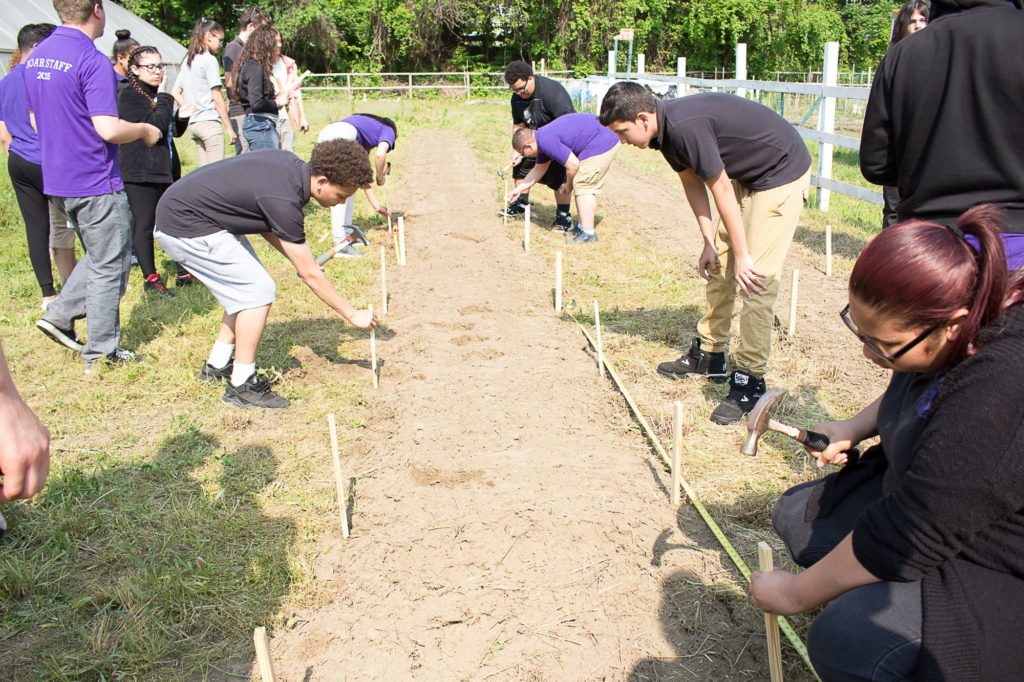
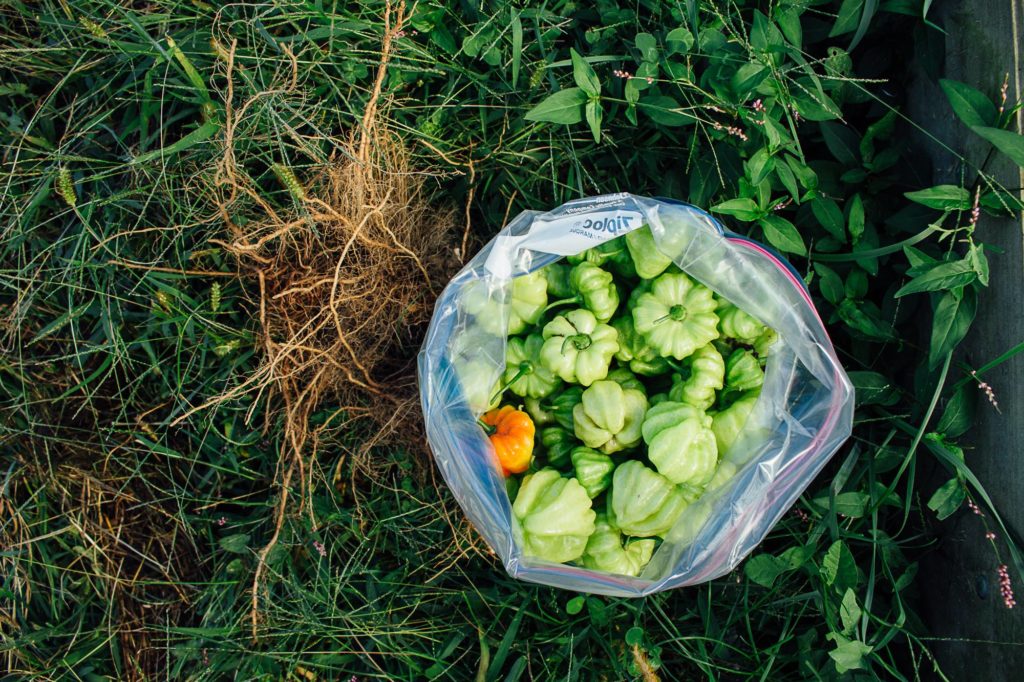
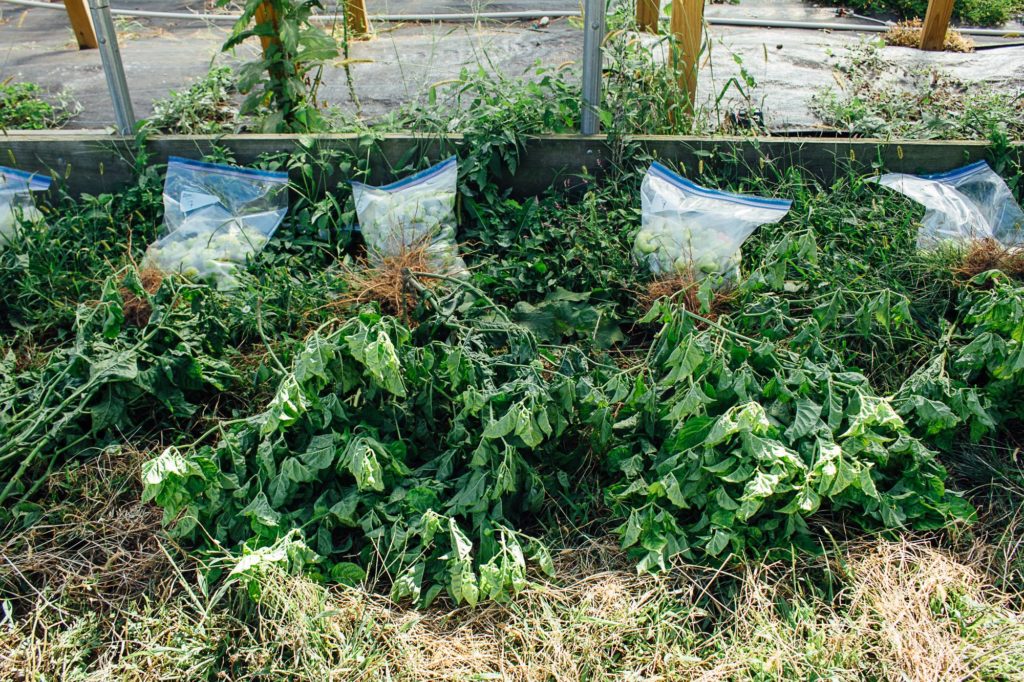
Let’s Remineralize! Grade 9-12
Pre-Experiment Discussion

- Before beginning the experiment, prime the students with discussion. You can begin by asking if any of the students garden or if theyknow anything about gardening. As students give their answers, develop the conversation by asking relevant questions or sharing from personal experience. When students have finished discussing their current relationship with gardening, ask what they know about climate change.
- Continue the discussion in the same format by asking relevant questions and drawing from personal experience. Once the students have shared their thoughts, bridge the two ideas together by asking them how they think gardening and climate change can be related. Use this discussion point as a transition into the pre-experiment learning materials provided.
Experiment Setup

- The aim of this experiment is to demonstrate the impactrock dust has on soil fertility with regards to yields, fruit size, the overall health of plants, and flowering and growth rates. To begin the experiment, select which plant(s) the class will be conducting the experiment with. The experiment can be conducted with one or more plants at a time. See the section “What To Grow” below for help on this subject.
- Once the choice of the plant(s) has been selected,plant the seeds into individual pots. Half of the pots will act as a control group and willonly contain local soil or purchased, bagged, organic soil from a local garden center or online store. (For bagged soils it might be better if it has fewer amendmentsso as to keep fewer factors in play for the control and experimental group, like Black Gold.)
- The other half will be the experimental group. Itwill contain a mixture of the same soil and rock dust. Fill the volume of the pots with95% soil and 5% rock dust. Weigh the material on a per-volume basis for each pot and determine those measurements. Blend the mixture thoroughly and fill the pots.
- Once the seeds have germinated, select 20 of the strongestseedlings to use in the planting trial, with 10 being grown in just soil and the other 10 being grown in the mixture of soil and rock dust. You can use more orless than 20 seedlings based on available resources (as long as exactly half are partof the control group and the other half are part of the experimental group).
- Grow lights may be needed in an indoor setting.
- Over the course of the next six weeks, the studentsshould take daily measurements of the seedling heights. This will provide quantitative data on growth rates during this initial stage.
- After the initial six weeks record qualitative observations such as plant vigor, flowering, and fruit quality. For quantitative data, record the number of flowers, fruits, and the weights/heights of the fruits grown for the rest of the duration of the experiment.
What To Grow
Vegetables such as lettuce, spinach, kale (and other salad greens), sweet peppers, radishes, tomatoes, carrots, zucchini, beets, squash, cucumbers, and okra, have been used successfully.
For a quick experiment, radishes are ideal since they have rapid maturation rates. Lettuce, spinach, and kale also have fast maturation rates. Make sure to look up the ideal temperature for your plant’s germination and maturation, as most plants grow slower in colder conditions.
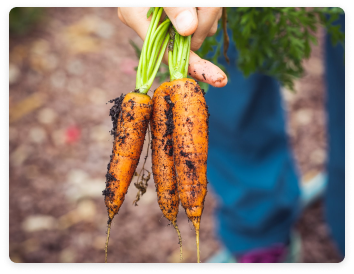
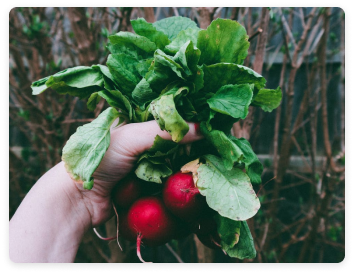
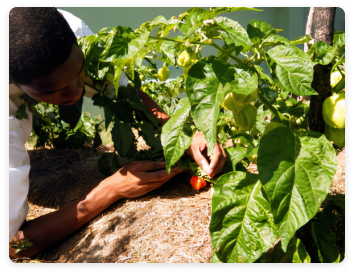
On the far right, a student inspects in the experimental phase of Let’s Remineralize! a vegetable grown out of soil with rock dust.
Analyzing Results

- After the trial concludes, have students organize their results through graphs, tables, or written out in paragraph form. Upon organizing their data, encourage students to draw conclusions and compare results with their peers.
- What did they conclude from their results? Were the results what they had anticipated? How did their results relate to what they already knew about rock dust and soil remineralization?
- Were there parts of the experiment that did not goas planned? Were there other factors they did not expect? Could any outside factors have impacted the results? What were the main differences between the control group and the experimental group?
- As a formal assessment of learning, have the studentswork with partners to create presentations about their findings. Make sure they are clearly able to identify and understand each step of the scientific method withinthe experiment, why they got the results they did, and the science behind soil remineralization.
- Repeated trials are encouraged! More data provides better-supported conclusions. Encourage students to design further experiments to improve plant growth.
Post-Experiment Discussion
After the experiment, return to some of the ideas from the pre-experiment discussion. Ask students how the experiment helped them better understand or has changed how they view climate change and their ability to help the environment. Discuss students’ ideas on how to address climate change or take their learning outside of the classroom.

Sharing Your Results
Please complete the survey where you will have an opportunity to upload your results as text, pictures, and videos. The results will appear on RTE’s GIS Map on your location to be shared with other teachers and students. As junior scientists, you will be making a contribution to our research database.
Thank you for your participation! Let’s Remineralize Survey.
Follow-up
RTE Resources
RTE WebsiteRTE Global Repair Conference Presentation
RTE Florence Organic Community Gardens Video
RTE Documentary on Remineralization in Rural Brazil
Documentaries
Dirt Rich DocumentaryKiss the Ground Documentary
From Forest to Garden Documentary
National Geographic
National Geographic Wind and Water Meet Rock VideoNational Geographic Weathering
National Geographic Interactive Soil Quality Activity
National Geographic Preserving Soils - World Cropland Density Map
National Geographic Soil Maintenance
National Geographic Agriculture
National Geographic Environmental Impacts of Agricultural Modifications
National Geographic Human Impact on Land Activity
Leverhulme Centre for Climate Change Mitigation
Leverhulme Centre for Climate Change MitigationArticles
Carbon Brief - ERW's Impact on Climate Change and Crop YieldsNature ERW Article
The Guardian Rock Dust and CO2 Removal Article
Columbia.edu Carbon Dioxide Removal Article
Columbia.edu Soil and Climate Change Article
ERW in Tropical Agriculture
Rock Dust and Tomatoes
Enhanced Rock Weathering on Farmland
Rock Dust and Food Security
Washington Post ERW Article
Huffington Post Soil Revolution
A Billion Ton Solution to Climate Change
Soil Education | NRCS
